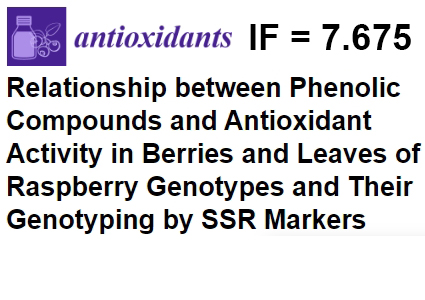Press-room / Digest

Relationship between phenolic compounds and antioxidant activity in berries and leaves of raspberry genotypes and their genotyping using SSR markers
Researchers from the Forest Biotechnology Group of the FIBCh together with colleagues from other institutes studied the content of total phenols, flavonoids and anthocyanins, their relationship with the antioxidant activity of berries and leaves of various raspberry cultivars of Russian and foreign origin, as well as new breeding lines. An optimal method for the analysis of antioxidant activity of raspberry was determined, breeding lines superior to standard cultivars were identified, and phenological phases for the maximum bioactive value of raspberry plants were established. In addition, for the first time, the relationship between the chemical diversity of plant cultivars and genetic markers specific for a particular metabolic pathway was studied. The strong correlation between biochemical and genetic data makes it possible to use these markers in the selection for improving nutritional properties, as well as to study the mechanisms of flower and fruit color formation. The study published in Antioxidants. Learn more

A Single Fluorescent Protein-Based Indicator with a Time-Resolved Fluorescence Readout for Precise pH Measurements in the Alkaline Range
The real-time monitoring of the intracellular pH in live cells with high precision represents an important methodological challenge. Most of the genetically encoded fluorescent indicators are hindered by the inability to determine an absolute pH value and/or a narrow dynamic range of the signal. The team of scientists from the Laboratory of genetically encoded molecular tools IBCh RAS studied the pH sensitivity of a green-fluorescence-protein (GFP)-based emitter (EGFP-Y145L/S205V) with the alkaline-shifted chromophore’s pKa and demonstrate that, in the pH range of 7.5–9.0, its fluorescence lifetime changes by a factor of ~3.5 in a quasi-linear manner in mammalian cells. Considering the relatively strong lifetime response in a narrow pH range, authors proposed the mitochondria, which are known to have a weakly alkaline milieu, as a target for live-cell pH measurements. Using FLIM they succeeded in determining the absolute pH value of the mitochondria and recorded the ETC-uncoupler-stimulated pH shift with a precision of 0.1 unit. Thus the scientists showed that a single GFP with alkaline-shifted pKa can act as a high-precision indicator that can be used in a specific pH range. The work is published in the International Journal of Molecular Sciences. Learn more

Hydrophobic Rose Bengal derivatives as photosensitizing antiviral agents
Rose Bengal (BR) is an anionic xanthene dye that is actively used as a photosensitizer, mainly for antibacterial and antitumor photodynamic therapy. The use of BR and its derivatives for virus inactivation has not been comprehensively studied. A team of scientists from the Department of functioning of living systems IBCh RAS in collaboration with colleagues from other Russian Institutes used a synthetic approach based on the successful design of photosensitizing antivirals to obtain BR derivatives for virus photoinactivation. A number of N-alkyl-substituted derivatives with the same 1O2 generation efficiency but completely different activity against SARS-CoV-2, CHIKV, and HIV have been synthesized and studied. Several compounds have activities in the submicromolar-subnanomolar ranges and high selectivity indices. The synthesized compounds are promising candidates for the development of inactivated vaccines. The work was published in Biomolecules (IF = 6.064).

The active site of ribokinase from E. coli was rationally modified for the optimization of cascade synthesis of arabinosides
Сascade synthesis of arabinosides is a promising approach for the production of various important antiviral and cancer suppressing drugs. However, the low activity of the cascades first enzyme - ribokinase towards D-arabinose limits the technological feasibility of this approach. Researchers from the lab. of Biopharmaceutical Technologies and lab. of Biosynthesis of Physiologically Active Compounds from the dep. of Biotechnology of IBCh RAS have performed the rational design in the active site of ribokinase from E. coli, resulting in a 15-fold increase in enzyme activity (k cat ) towards D-arabinose through the A98G mutation. The engineered mutant has allowed to decrease the consumption of this enzyme by an order of magnitude with no loss in the efficiency of synthesis of the model arabinoside. The results were published in International Journal of Molecular Sciences (IF=6.208, Q1).

Chemo-enzymatic synthesis of 5-substituted ribavirin analogs: Unexpected cooperative effect in the interaction of 5-alkyloxymethyl 1,2,4-triazol-3-carboxamides with E. coli purine nucleoside phosphorylase active site
A team of scientists from the Department of Biotechnology of IBCh in collaboration with colleagues from ITHT-RTU-MIREA synthesized a series of 5-alkyl/aryl-hydroxymethyl- ribavirin analogs. Ribonucleosides were synthesized by classical chemical glycosylation, while 2'-deoxyribonucleosides were synthesized by transglycosylation with E. coli PNP. When studying the kinetic parameters, a positive cooperative effect of PNP active sites was discovered for the first time. Nucleosides were active against herpes simplex virus type 1 (HSV-1) and influenza virus H5N1. The work was published in the journal Sustainable Chemistry and Pharmacy (IF 5.464, Q2).

